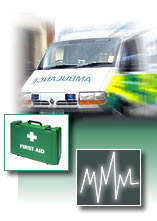| |
 |
 |
Position the heel of one hand
on the centre of the breastbone between the nipples. Place the
second hand on first. Compress chest one third to half the depth
of the chest. |
 |
Press down smoothly and firmly
with 15 compressions followed by two slow breaths, this is counted
as one cycle. |
 |
After approximately four cycles
(1 minute) of 15 compressions followed by two slow breaths, re-check
and assess signs of circulation
and breathing. |
 |
Keep this going until the casualty
shows signs of life, qualified help arrives or you become exhausted. |





